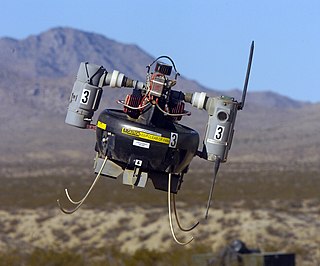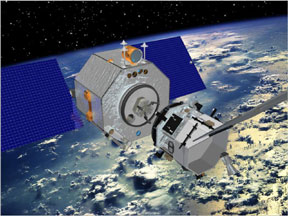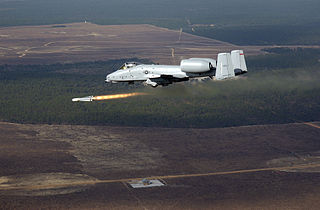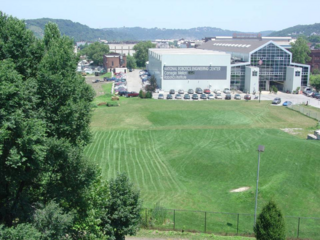
Automated aerial refueling (AAR) refers to methods for autonomous refueling of manned and unmanned aircraft.

Automated aerial refueling (AAR) refers to methods for autonomous refueling of manned and unmanned aircraft.
An Air Force Research Laboratory program was started in 2004 at the AFRL Air Vehicles Directorate. The initial program was the evaluation of technologies that could be used for AAR. The key new concept is the use of precision GPS. The AAR program has since held several flight tests. The important factors were the software and communication systems that kept the aircraft at the proper altitude and speed.[ citation needed ]
In 2007, the Defense Advanced Research Projects Agency (DARPA), with the help of NASA, demonstrated automatic refuelling from a conventional tanker by a high-performance aircraft. A pilot was on board to supervise, so the demonstration was not entirely automated. [1] It served as the basis for DARPA's Autonomous High-Altitude Refueling (AHR) program which, in 2012, demonstrated the potential for fully autonomous aerial refueling of unmanned high-altitude long-endurance aircraft. [2] [3] The final test involved two modified Northrop Grumman RQ-4 Global Hawk aircraft flying in close formation less than 100 feet from a tanker, close enough for refueling to take place, at 44,800 feet altitude. [2] [4] [5]
Appropriate flight control systems (FCS) include sensors to detect the position of the tanker and its refueling drogue along with rules to control the client aircraft. Several different techniques have been proposed for controlling the refueling process. One proposal involves the use of LED beacons on the drogue and an optical sensor on the tanker to determine the drogue's position and attitude. A second involves treating the drogue's position as fixed, ignoring turbulence with the help of a low-pass filter in the control system. [6]

The Defense Advanced Research Projects Agency (DARPA) is a research and development agency of the United States Department of Defense responsible for the development of emerging technologies for use by the military.

The Northrop Grumman RQ-4 Global Hawk is a high-altitude, remotely-piloted surveillance aircraft introduced in 2001. It was initially designed by Ryan Aeronautical, and known as Tier II+ during development. The RQ-4 provides a broad overview and systematic surveillance using high-resolution synthetic aperture radar (SAR) and electro-optical/infrared (EO/IR) sensors with long loiter times over target areas.

An unmanned aerial vehicle (UAV), commonly known as a drone, is an aircraft without any human pilot, crew, or passengers on board. UAVs were originally developed through the twentieth century for military missions too "dull, dirty or dangerous" for humans, and by the twenty-first, they had become essential assets to most militaries. As control technologies improved and costs fell, their use expanded to many non-military applications. These include aerial photography, area coverage, precision agriculture, forest fire monitoring, river monitoring, environmental monitoring, policing and surveillance, infrastructure inspections, smuggling, product deliveries, entertainment, and drone racing.

Aerial refueling, also referred to as air refueling, in-flight refueling (IFR), air-to-air refueling (AAR), and tanking, is the process of transferring aviation fuel from one aircraft to another while both aircraft are in flight. The two main refueling systems are probe-and-drogue, which is simpler to adapt to existing aircraft, and the flying boom, which offers faster fuel transfer, but requires a dedicated boom operator station.

A micro air vehicle (MAV), or micro aerial vehicle, is a class of man-portable miniature UAVs whose size enables them to be used in low-altitude, close-in support operations. Modern MAVs can be as small as 5 centimeters - compare Nano Air Vehicle. Development is driven by commercial, research, government, and military organizations; with insect-sized aircraft reportedly expected in the future. The small craft allow remote observation of hazardous environments or of areas inaccessible to ground vehicles. Hobbyists have designed MAVs for applications such as aerial robotics contests and aerial photography. MAVs can offer autonomous modes of flight.

The Boeing X-45 unmanned combat air vehicle is a concept demonstrator for a next generation of completely autonomous military aircraft, developed by Boeing's Phantom Works. Manufactured by Boeing Integrated Defense Systems, the X-45 was a part of DARPA's J-UCAS project.

The Airbus A310 MRTT Multi-Role Tanker Transport is a military air-to-air refuelling, or in-flight refuelling tanker transport aircraft, capable of operating multi-role missions. The A310 MRTT tanker aircraft is a subsequent development from the earlier Airbus A310 MRT Multi-Role Transport, which was a military transport aircraft for passengers, cargo, and medical evacuation. The A310 MRT and A310 MRTT are both specialist military conversions of existing airframes of the civilian Airbus A310-300C wide-bodied passenger jet airliner.

The NASA Pathfinder and NASA Pathfinder Plus were the first two aircraft developed as part of an evolutionary series of solar- and fuel-cell-system-powered unmanned aerial vehicles. AeroVironment, Inc. developed the vehicles under NASA's Environmental Research Aircraft and Sensor Technology (ERAST) program. They were built to develop the technologies that would allow long-term, high-altitude aircraft to serve as atmospheric satellites, to perform atmospheric research tasks as well as serve as communications platforms. They were developed further into the NASA Centurion and NASA Helios aircraft.

AeroVironment, Inc. is an American defense contractor headquartered in Arlington, Virginia, that designs and manufactures unmanned aerial vehicles (UAVs). Paul B. MacCready Jr., a designer of human-powered aircraft, founded the company in 1971. The company is best known for its lightweight human-powered and solar-powered vehicles. The company is the US military's top supplier of small drones —notably the Raven, Switchblade, Wasp and Puma models.

The Boeing A160 Hummingbird is an unmanned aerial vehicle (UAV) helicopter. Its design incorporates many new technologies never before used in helicopters, allowing for greater endurance and altitude than any helicopter currently in operation.

The Northrop Grumman X-47B is a demonstration unmanned combat aerial vehicle (UCAV) designed for aircraft carrier-based operations. Developed by the American defense technology company Northrop Grumman, the X-47 project began as part of DARPA's J-UCAS program, and subsequently became part of the United States Navy's Unmanned Combat Air System Demonstration (UCAS-D) program. The X-47B is a tailless jet-powered blended-wing-body aircraft capable of semi-autonomous operation and aerial refueling.

Orbital Express was a space mission managed by the United States Defense Advanced Research Projects Agency (DARPA) and a team led by engineers at NASA's Marshall Space Flight Center (MSFC). The Orbital Express program was aimed at developing "a safe and cost-effective approach to autonomously service satellites in orbit". The system consisted of two spacecraft: the ASTRO servicing satellite, and a prototype modular next-generation serviceable satellite; NEXTSat. The mission launched from Cape Canaveral Air Force Station on 8 March 2007, aboard an Atlas V expendable launch vehicle. The launch was part of the United States Air Force Space Test Program STP-1 mission.

Aurora Flight Sciences (AFS) is an American aviation and aeronautics research subsidiary of Boeing that specializes in special-purpose unmanned aerial vehicles. Aurora's headquarters is at Manassas Regional Airport.

The Boeing Phantom Ray is an American demonstration stealth unmanned combat air vehicle (UCAV) developed by Boeing using company funds. The autonomous Phantom Ray is a flying wing around the size of a conventional fighter jet, and first flew in April 2011. It will conduct a program of test flights involving surveillance, ground attack and autonomous aerial refueling missions. The developers say it can carry 4,500 pounds of payload.

KQ-X was a $33 million DARPA program awarded to Northrop Grumman on July 1, 2010. KQ-X investigated and developed autonomous aerial refueling techniques using two NASA Global Hawk high-altitude long endurance (HALE) unmanned aerial vehicles (UAVs).

Persistent Close Air Support (PCAS) is a DARPA program that seeks to demonstrate dramatic improvements in close air support (CAS) capabilities by developing a system to allow continuous CAS availability and lethality to Joint Terminal Attack Controllers (JTACs).

The National Robotics Engineering Center (NREC) is an operating unit within the Robotics Institute (RI) of Carnegie Mellon University. NREC works closely with government and industry clients to apply robotic technologies to real-world processes and products, including unmanned vehicle and platform design, autonomy, sensing and image processing, machine learning, manipulation, and human–robot interaction.
An autonomous aircraft is an aircraft which flies under the control of on-board autonomous robotic systems and needs no intervention from a human pilot or remote control. Most contemporary autonomous aircraft are unmanned aerial vehicles (drones) with pre-programmed algorithms to perform designated tasks, but advancements in artificial intelligence technologies mean that autonomous control systems are reaching a point where several air taxis and associated regulatory regimes are being developed.

The Boeing MQ-25 Stingray is an aerial refueling drone that resulted from the Carrier-Based Aerial-Refueling System (CBARS) program, which grew out of the earlier Unmanned Carrier-Launched Airborne Surveillance and Strike (UCLASS) program. The MQ-25 first flew on 19 September 2019.